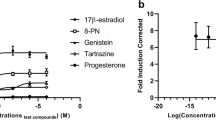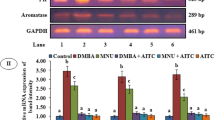Summary
The antineoplastic activity of 4-chloro-2-(2,6-dichloro-4-hydroxyphenyl)-1-ethyl-6-hydroxyindole (D 15413) was determined in several estrogen-dependent mammary tumor models. The growth of DMBA-induced rat mammary carcinomas was inhibited by doses ranging from 2 to 18 mg/kg. A dose of 6×12 mg/kg per week p.o. reduced the tumor area by 82% (control+192%). D 15413 was also active against MNU-induced rat mammary tumors and transplanted MXT tumors of the mouse. In vitro, the growth of estrogen receptor positive MCF-7 breast cancer cells was inhibited by D 15413 (10−8–10−5 M). A mode of action considering endocrine and cytotoxic effects is discussed.
Similar content being viewed by others
References
Angerer E von (1984) Development of new drugs for endocrine tumour chemotherapy. Cancer Treat Rev 11 (Suppl. A): 147–153
Angerer E von, Prekajac J (1983) Hydroxyphenyl indoles: a new class of mammary tumor inhibiting compounds. J Med Chem 26:113–116
Angerer E von, Prekajac J, Strohmeier J (1984) 2-Phenyl-indoles. Relationship between structure, estrogen receptor affinity, and mammary tumor inhibiting activity in the rat. J Med Chem 27:1439–1447
Angerer E von, Prekajac J, Berger M (1985) The inhibitory effect of 5-acetoxy-2-(4-acetoxyphenyl)-1-ethyl-3-methylindole (D 16726) on estrogen-dependent mammary tumors. Eur J Cancer Clin Oncol 21:531–537
Black LJ, Goode RL (1980) Uterine bioassay of tamoxifen, trioxifene and a new estrogen antagonist (LY 117018) in rats and mice. Life Sci 26:1453–1458
Koziol AJ, Donna AM (1981) A distribution-free test for tumor growth curve analysis with application to an animal tumor growth curve analysis with application to an animal tumor immunotherapy experiment. Biometrics 37:383–390
Leclercq G, Danguy A, Heuson JC (1984) MXT mouse mammary tumor: growth inhibition by tamoxifen or oestrogen administration. IRCS Med Sci 12:218–219
Maass H, Jonat W, Stolzenbach G, Trams G (1980) The problem of nonresponding estrogen receptor-positive patients with advanced breast cancer. Cancer 46:2783–2787
Mann HB, Whitney DR (1947) On a test whether one or two random variables is stochastically larger than the other. Am Math Statist 18:50–60
Nagasawa H, Nozaki D, Niki K, Namiki K (1985) Effects of 2-(hydroxyphenyl)indoles on the formation of preneoplastic mammary hyperplastic alveolar nodules and uterine adenomyosis in SHN virgin mice. Mem Inst Techn, Meiji Univ in press
Ogasawara J, Okamoto S, Kitamura J, Matsumoto K (1983) Proliferative pattern of uterine cells from birth to adulthood in intact, neonatally castrated and/or adrenalectomized mice, assayed by incorporation of [125I]iododeoxyuridine. Endocrinology 113:582–587
Richter A, Sandford KK, Evans VJ (1972) Influence of oxygen and culture medium on plating efficiency in some mammalian tissue culture cells. J Natl Cancer Inst 49:1705–1712
Scholl SM, Huff KK, Lippman ME (1983) Antiestrogenic effects of LY 117018 in MCF-7 cells. Endocrinology 113:611–617
Author information
Authors and Affiliations
Additional information
Dedicated to Professor D. Schmähl on the occasion of his 60th birthday
Supported by the Deutsche Forschungsgemeinschaft, Sonderforschungsbereich 234, and by the Verband der Chemischen Industrie, Fonds der Chemischen Industrie
Rights and permissions
About this article
Cite this article
von Angerer, E., Prekajac, J., Schneider, M.R. et al. The inhibitory effect of 4-chloro-2-(2,6-dichloro-4-hydroxyphenyl)-1-ethyl-6-hydroxyindole (D 15413) on estrogen-dependent mammary tumors. J Cancer Res Clin Oncol 110, 216–220 (1985). https://doi.org/10.1007/BF00399276
Received:
Accepted:
Issue Date:
DOI: https://doi.org/10.1007/BF00399276




